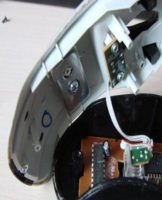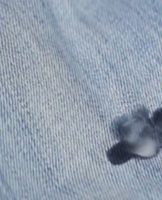How to properly maintain a cast iron cauldron, common problems and storage
Kazan is a universal cast-iron dish. The classic container is made in the form of a cauldron with a semicircular bottom and a lid, designed for cooking over fire. Dishes prepared in this way are tastier and more aromatic. Cast iron cookware, with proper care, is durable. For it to last as long as possible, it is important to know how to properly maintain a cast iron cauldron.
Calcination of a new cast iron cauldron
Cast iron is a material that is made by pressing or casting an iron alloy. The composition contains a small percentage of carbon, which over time leads to the formation of corrosion. To prevent this from happening, in the production of dishes they are treated with technical oil. Before the first use, it is necessary to eliminate the fat of production by calcination. It is carried out once after the purchase of the dishes.
You can remove the oily layer with salt. If the activity is carried out in an apartment, it is recommended to ventilate the room as a sufficient amount of smoke will be generated. Salt is poured into the cauldron, the stove is turned on. Stir the salt periodically, wait until it browns. Then it is removed, the walls of the container are wiped with paper. The second stage of processing is started.
A cast iron cauldron is lubricated with sunflower oil so that the walls inside are saturated, a film is formed. It protects food from sticking and sticking. Sunflower oil is poured into the cauldron and the dishes are heated. Animal fat is suitable for lubricating the walls. It is optimal to use linseed oil, it clogs the pores of the metal faster, forming a thin film on the surface. Warm the container with oil for half an hour. Then turn off the stove, cool the cauldron, wipe the walls with a clean cloth. The utensils are then ready for cooking.
How to properly wash a product after cooking?
Proper maintenance of the cast iron cauldron will help preserve the original appearance of the product for a long time and extend its service life. It does not require special care, it is only important to adhere to certain recommendations.
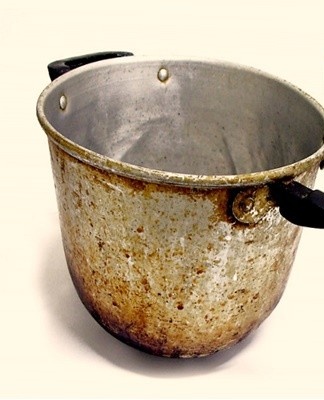
At home
After the initial treatment, food residue does not adhere to the walls and bottom, so preliminary cleaning and soaking is not necessary. It is not recommended to wash cast iron dishes with a wire brush. The cauldron is freed from food debris. Fill the container with water, bring it to a boil. Then it is cooled, washed with a sponge using detergents.
In the field
In nature, you can quickly clean the cauldron from dirt. After cooking over a wood fire, the dishes are cleared of food debris and filled to the brim with river sand. In this form, the cauldron is left to warm over the embers until morning. Then remove the dishes from the heat, let cool. Remove the sand, fill the container with salt, turn on. After the salt blackens, pour out the contents, wipe the inside with a dry cloth.
Solve common problems
Depending on the type of contamination, the methods of maintaining a cast iron cauldron differ. Caring for dinnerware involves the following steps: cleaning, soaking, boiling.Despite the "rough" appearance, cast iron cookware requires careful handling.
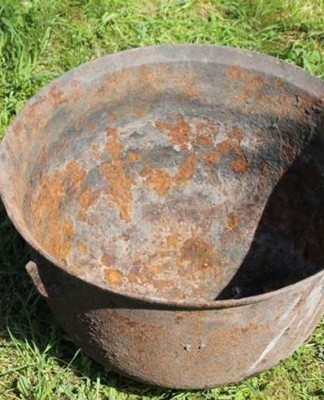
Nagar
To clean the surface of a cast-iron cauldron from carbon deposits, it is forbidden to use household chemicals. Such agents destroy the structure of the oil film, the surface deteriorates rapidly. Conventional detergents or folk recipes will help to cope with pollution. A mixture of salt and water cleans the container well from carbon deposits. The gruel is applied to the contaminated area, wiped with a sponge and washed off with water.
Laundry soap and stationery glue will help remove carbon deposits at home. The dishes are washed using a detergent. Lower the container into the bucket. A mixture is prepared from a grated bar of soap and 100 grams of glue. Fill the bucket with water, put it on the stove. Add the prepared mixture and dissolve in water. The contents are boiled for 2-3 hours. Clean the cauldron with a sponge, rinse with water.
Odors
If a musty smell develops, it can be eliminated in several ways. In the first case, you can simply ignite the cauldron with oil, the smell will disappear. You can use table salt to ignite the container.
In the second case, boiling water with vinegar helps a lot. Prepare a solution in a ratio of 1: 1. After this method of cleaning, you will need to relight the cauldron.
Rust
Moisture is the main enemy of the cast iron cauldron, because the material contains iron.When the first signs of corrosion appear, they must be eliminated immediately, otherwise the dishes will become unusable. Small spots of corrosion are removed with baking soda. The product is applied to the problem area, a drop of water is added and the area is cleaned with a sponge. Leave for 10 minutes, then repeat the procedure. Rinse the cauldron under running water.
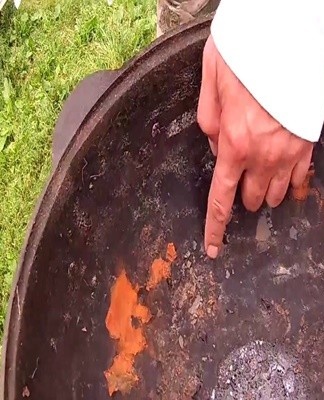
Thick layers of rust can be removed with vinegar. It is mixed with water in a 1: 1 ratio. Place the cauldron in this solution and leave for 3 hours. Clean the problem area with a wire brush.
Care and Storage Features
The main condition for storing a cast iron cauldron is the absence of moisture. After washing, the dishes are dried. For storage, choose a room with moderate humidity. In case of frequent use of the cauldron, wipe the inside with oil. If the dishes are used in rare cases, the outer walls are also treated with oil.
The cauldron should be kept with the lid ajar. It is necessary to provide free access to air, otherwise an unpleasant smell will appear inside.
Observance of tips and tricks will extend the life of the cast iron product, help get rid of unnecessary troubles associated with the formation of rust, mold and an unpleasant smell. Proper care and storage allow you to enjoy delicious and aromatic dishes cooked in a cauldron for longer.

